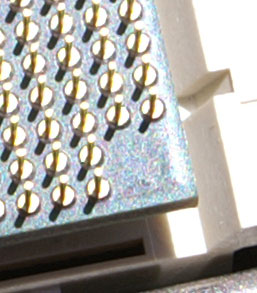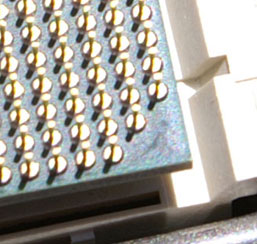AMD Socket-AM2: Same Performance, Faster Memory, Lower Power
by Anand Lal Shimpi on May 23, 2006 12:14 PM EST- Posted in
- CPUs
AM2 in Detail
Of course the most prominent feature of AMD's Socket-AM2 platform is the new socket and its support for DDR2 memory. As we've already mentioned, Socket-AM2 is a 940-pin socket that is keyed differently from the original 940-pin Athlon 64/Opteron sockets; only AM2 processors will physically fit into an AM2 motherboard.

Socket-939 (left) vs. Socket-AM2 (right)
Socket-939 |
Socket-AM2 |
 |
 |
One of the Athlon 64's strongest selling points continues to be its on-die memory controller, which has of course been significantly changed for the new Socket-AM2 platform. All AM2 CPUs feature a 128-bit wide DDR2 memory controller, compared to the 128-bit DDR memory controller that we've come to know from the Socket-939 platform. A DDR2 memory interface actually requires more pins than a DDR1 interface, but AMD was able to keep the AM2 pin count down by removing a large number of unnecessary pins on the Athlon 64's package. When the Socket-940/939 Athlon 64s were first designed, approximately 10% of their pins were redundant and could be removed in later designs. Not desiring to introduce a new socket as frequently as its competition had, AMD waited until Socket-AM2 to remove those unnecessary pins thus enabling a dual-channel DDR2 interface in virtually the same pin count as the earlier DDR1 equipped CPUs.
All of the Socket-AM2 CPUs support up to DDR2-667, but the AM2 Athlon 64 X2 and Athlon 64 FX models support up to DDR2-800. Since Socket-AM2 unifies AMD's desktop socket strategy, all Semprons, Athlon 64s, X2s and FX processors will feature this dual channel DDR2 memory controller.

Corsair partnered with AMD and NVIDIA for the Socket-AM2 and nForce 500 review kits
The lineup of Socket-AM2 processors being introduced today are in the table below:
| CPU | Clock Speed | L2 Cache Size | TDP | Price |
| AMD Athlon 64 FX-62 | 2.8GHz | 1MBx2 | 125W | $1031 |
| AMD Athlon 64 X2 5000+ | 2.6GHz | 512KBx2 | 89W | $696 |
| AMD Athlon 64 X2 4800+ | 2.4GHz | 1MBx2 | 89W | $645 |
| AMD Athlon 64 X2 4600+ | 2.4GHz | 512KBx2 | 89W | $558 |
| AMD Athlon 64 X2 4400+ | 2.2GHz | 1MBx2 | 89W | $470 |
| AMD Athlon 64 X2 4200+ | 2.2GHz | 512KBx2 | 89W | $365 |
| AMD Athlon 64 X2 4000+ | 2.0GHz | 1MBx2 | 89W | $328 |
| AMD Athlon 64 X2 3800+ | 2.0GHz | 512KBx2 | 89W | $303 |
| AMD Athlon 64 3800+ | 2.4GHz | 512KB | 62W | $290 |
| AMD Athlon 64 3500+ | 2.2GHz | 512KB | 62W | $189 |
| AMD Sempron 3600+ | 2.0GHz | 256KB | 62W | $123 |
| AMD Sempron 3500+ | 2.0GHz | 128KB | 62W | $109 |
| AMD Sempron 3400+ | 1.8GHz | 256KB | 62W | $97 |
| AMD Sempron 3200+ | 1.8GHz | 128KB | 62W | $87 |
| AMD Sempron 3000+ | 1.6GHz | 256KB | 62W | $77 |
There's basically no price premium for the new Socket-AM2 chips, encouraging a quick transition to AMD's new DDR2 platform.
You will also notice that none of the model numbers have changed, so an Athlon 64 X2 4800+ on Socket-AM2 has the same clock speed and L2 cache size as the Socket-939 version. Since AMD's model numbers haven't changed, you already know not to expect any major changes in performance with Socket-AM2. In fact, the only difference on the CPU side is the introduction of the new Athlon 64 FX-62, Athlon 64 X2 5000+ and Athlon 64 X2 4000+.










83 Comments
View All Comments
mlittl3 - Tuesday, May 23, 2006 - link
Until K8L (which will have microarchitectural improvements), there are a few things that could allow AMD to look good against Core 2.1) Price drops so that comparable K8 and Core 2 processors are the same price giving the same performance/$ ratio (this metric is important for the budget constrained)
2) Nov. '06 release of 65 nm AM2 processors so that K8 and Core 2 processors will have the same performance/watt ratio (65 nm could give K8 a 20% drop in power and with Core 2 being 20% faster, they will have the same performance/watt ratio which is popular now). Also, everytime AMD transitions to a new die process they add some minor bug fixes and minor memory/microarchitectural enhancements which could also boost performance by a few percent.
3) Continual improvements to DDR2 latency might yield a 2-2-2 DDR2 800 memory module which will probably benefit K8 more (maybe ~5% improvement) than Core 2 but this is a wild guess here and I don't know if it is even possible. However, DDR400 latency started around 4-4-4 and dropped to 2-2-2 so it could happen.
With the same performance/price and performance/watt as Core 2, K8 could stay competitive and OEMS and users decide on which company (if not both) they would like to do business with. This is all speculation and of course everyone is more than welcome to rip my reasoning to death.
JarredWalton - Tuesday, May 23, 2006 - link
I seriously doubt we will ever see DDR2-800 running at 2-2-2 timings. (Feel free to quote me on this in the future and make fun of me if I'm proven wrong. :-)) Just think how long we had DDR memory around, and no one ever managed to create 1-1-1 DDR-400 memory. I do think we will see 3-3-3 DDR2-800, and possibly even higher bandwidth with those timings. In fact, we almost have that already judging from my experiences so far with socket AM2. (I can post and run benchmarks, but I wouldn't call the system 100% stable.)mlittl3 - Tuesday, May 23, 2006 - link
LOL! I will!MacGuffin - Tuesday, May 23, 2006 - link
From Patriot's PDC22G8000+XBLK Rev. 2 review on PCSTATS.Rated for DDR2-667 @ 3-3-3-9 (Maintains those timings through DDR2-940!)
Rated for DDR2-1000 @ 4-4-4-12 (Goes Up to DDR2-1020!)
Completely stable on the Intel platform they used. It's extremely expensive (saw it for $400+ at NewEgg). But yes, it is possible to run 2GB at these timings already. Its just extremely expensive.
EdisonStarfire - Tuesday, May 23, 2006 - link
any opinions on AMD offering a Clearspeed solution as stop-gap in the high end desktop arena ?Griswold - Tuesday, May 23, 2006 - link
The bottom line is, we now know what we knew last fall, or rather (rightfully) assumed.Now you made me curious. Could that be the "noise in june" which Henri Richards mentioned in a Register interview earlier this month?
smn198 - Wednesday, May 24, 2006 - link
It is called quad-core.temp2 - Tuesday, May 23, 2006 - link
The extremetech.com article has a similar teaser at the end, but it is slightly more specific:
"And given recent discussions with AMD, we can safely say that the company hasn't launched its last FX series CPU for the year quite yet."
mino - Wednesday, May 24, 2006 - link
This provided, 3.2 or even 3.4 FX's on 65nm are on the way...Scrogneugneu - Tuesday, May 23, 2006 - link
Beware the mighty Sempron FX 32 !